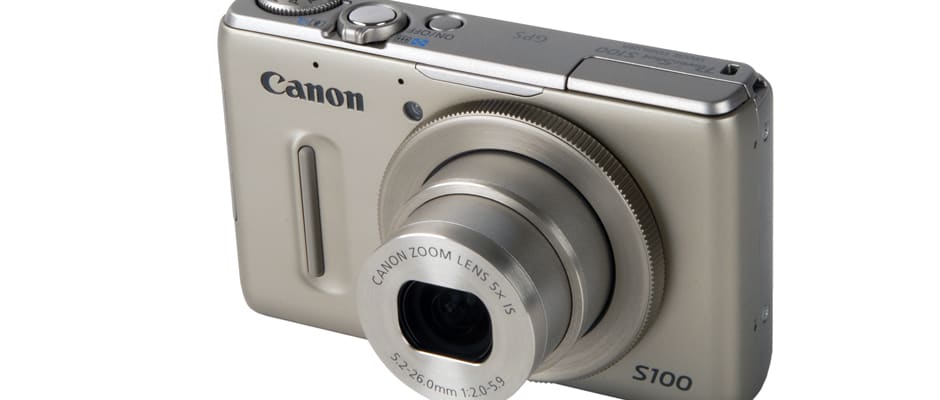Pros
Cons
Introduction
Front
{{section_header}}{{section.name}}{{/section_header}}

Back
{{section_header}}{{section.name}}{{/section_header}}

Sides
{{section_header}}{{section.name}}{{/section_header}}

Top
{{section_header}}{{section.name}}{{/section_header}}

Bottom
{{section_header}}{{section.name}}{{/section_header}}

In the Box
{{section_header}}{{section.name}}{{/section_header}}

In the box:
• Canon PowerShot S100 digital camera
• battery pack NB-5L with terminal cover
• battery charger CB-2LX
• USB cable
• wrist strap
• "Getting Started" guide
• Canon Digital Camera Solution Disk
• warranty card
Color
{{section_header}}{{section.name}}{{/section_header}}
Color accuracy is solid, but doesn't quite reach levels we were hoping for from Canon. In the most accurate color mode, Neutral, flesh tones are way off, though reds and magentas are pretty close. Scenes were also undersaturated by about 9%, which at least makes sense here at the "neutral" setting. Still, with skin tones inaccurate as they are, human subjects may appear unnatural and unflattering. More on how we test color.
Despite the relatively mediocre score, the S100's reproduction of color is still better than some of this camera's closest competition. Canon's own PowerShot G12, another high-end compact, fared much worse in our color test. Even the Olympus XZ-1 lagged behind, as did the Panasonic Lumix LX5, and some Panasonics have been known to ace this test.
Color Modes
{{section_header}}{{section.name}}{{/section_header}}
While the Neutral color mode appears relatively dull compared to others, it is the best choice and the one we used for the remainder of our tests. Second to that, simply turning off all color modes (or "My Colors") is only slightly less accurate, but this setting oversaturates by about 14%. Most other color modes are too far off to be useful.
Noise
{{section_header}}{{section.name}}{{/section_header}}
At standard studio illumination and default noise reduction settings, the S100's handling of unwanted image noise is very impressive. Artifacting rates are below 0.50% at ISO 80 or 100, and levels remain low until ISO 1600, before spiking up from there. More on how we test noise.
In low light, noise levels are even lower, and follow the exact same trend: barely any noise before ISO 1600, with a sharp spike afterward. At each light level, luminance noise makes up more of the total than chroma noise, so expect to see more grain than colored artifacts.
All four of these cameras produce attractive images at the low end and middle portions of the ISO range. The S100 has a tendency to render more grain than say the Olympus XZ-1, but Canon's noise reduction preserves edges more cleanly with less smudging. Color saturation is also preserved, even at the highest ISOs, and this cannot be said for the G12 or the XZ-1.
{{comparison_bars title="Noise Score Comparison", attribute="Noise Score", xLabel="Noise Score"}}
ISO
{{section_header}}{{section.name}}{{/section_header}}
A full range of ISO options are available, with levels stretching from 80 to 6400, all full resolution. Users can also manually dial in their ISO in third-stop increments, instead of jumping from 200 to 400 for example, the S100 supports 200, 250, 320, and 400, with similar options for each stop.
NOTE: The images above are not used in our testing or scoring, but are included here to show real-world examples of the differences between cameras at the various ISO settings.
Resolution
{{section_header}}{{section.name}}{{/section_header}}
All four of the cameras compared here spent extra effort equipping their models with relatively advanced glass, yet the S100 surpasses them all. The margin is tight, but most of the S100's lens-related efforts are better than the competition. More on how we test resolution.
Distortion ({{product.raw_scores['Distortion Score']}})
Because distortion is easily corrected in software, we often see cameras–even cheap point-and-shoots–earning the maximum score here. But these four all favor raw data over processing enhancement, and the resulting scores are lower. Distortion is the only lens test that the S100 doesn't lead, it's outdone by the Lumix LX5, yet still better than the Olympus XZ-1 and a major improvement over the G12.
Sharpness ({{product.raw_scores['Sharpness Score']}})
The S100's ability to resolve fine detail is excellent. In our test, the camera detected up to 2200 MTF50's at the widest and middle focal lengths, with sharpness dropping off very slightly at 5x zoom. The results are slightly better than the Olympus XZ-1 and much better than the Canon G12 and Panasonic LX5.
Chromatic Aberration ({{product.raw_scores['Chromatic Aberration Score']}})
Like all of the finely tuned cameras in our comparison group, chromatic aberration is essentially absent from sample shots. It was therefore unsurprising when the S100 aced our chromatic aberration test. When fringing does appear, it occurs in the typical spots: the edges of the frame at the longer focal lengths.
Quality & Size Options
{{section_header}}{{section.name}}{{/section_header}}
The S100 offers five aspect ratio settings (16:9, 3:2, 4:3, 1:1, and 4:5) with four shooting resolutions for each one, plus a single 4:3 resolution for RAW shooting. This adds up to a grand total of 21 different shooting resolutions. Beyond that, two compression quality settings, Fine and Normal, may be selected for each resolution, though the option is not available in RAW.
Image Stabilization
{{section_header}}{{section.name}}{{/section_header}}
Images were already fairly detailed by the time the S100's image stabilization took over, registering 83 MTF50's of detail on average. The stabilizer boosts this figure up to 92, a 9% improvement. More on how we test image stabilization.
The best stabilizer of this comparison group belongs to the Canon G12, which increased image quality by 37%. The G12 produced less overall detail than the S100 though, 34 MTF50's without image stabilization and 54 with the feature active.
{{comparison_bars title="Stabilization Score Comparison", attribute="Stabilization Score", xLabel="Stabilization Score"}}
Video Mode
{{section_header}}{{section.name}}{{/section_header}}
Video capture is possible in Full HD 1080p at 24 frames per second, and also at reduced resolutions like 720p and 480p at 30 frames per second. Optical zoom is unlocked while recording, although speed is slowed to reduce mechanical noise. Autofocus is pretty snappy while a recording is in progress, but otherwise no other control access is allowed.
Video Color
{{section_header}}{{section.name}}{{/section_header}}
Color accuracy takes a nosedive while shooting video, as it often tends to do. All shades are darker than they should be, and the scene is undersaturated by 16%, which is quite a bit even for less expensive compact cameras. More on how we test video color.
{{comparison_bars title="Video Color Score Comparison", attribute="Video Color Score", xLabel="Video Color Score"}}
Video Sharpness
{{section_header}}{{section.name}}{{/section_header}}
Of all the cameras in our comparison group, the S100 is sharpest while shooting video. We measured 500 lw/ph of detail horizontally and a whopping 625 lw/ph vertically. This might very well be the best score yet from an ultracompact. More on how we test video sharpness.
{{comparison_bars title="Video Color Sharpness Comparison", attribute="Video Sharpness Score", xLabel="Video Sharpness Score"}}
Playback Mode
{{section_header}}{{section.name}}{{/section_header}}
Image review is fast and intuitive thanks to the S100's excellent control layout. Using a combination of the zoom lever and rear control dial, users may navigate between images with ease. Shots may be grouped automatically by type, or by manually selecting favorites. Video playback is also painless, and operated by a clear onscreen display capable of normal, slow motion, fast forward, or frame by frame playback.
In-Camera Editing
{{section_header}}{{section.name}}{{/section_header}}
In-camera editing is pretty basic, with only minimal advanced functionality. Crop, resize, and all available, along with red-eye correction and application of color modes. Some light video editing options are available separately, inside the video playback onscreen display.
Direct Print Options
{{section_header}}{{section.name}}{{/section_header}}
Full direct printing options are available, including multiple shot tagging with up to 99 copies each, as well as PictBridge support for easy home printing.
Display
{{section_header}}{{section.name}}{{/section_header}}
An optical viewfinder, or even a shoe with which to attach one, would've been a significant departure from the S95's design and–we think–an improvement. No such luck however, the S100's rear LCD is the only available method of framing shots. For what it's worth, the monitor is excellent. It measures three inches diagonally, and has a relatively high 461,000-dot resolution. Colors are very accurate to the final product, but be aware that dynamic range seems to be enhanced a bit, so shots may need some editing to print exactly the way they appear onscreen.

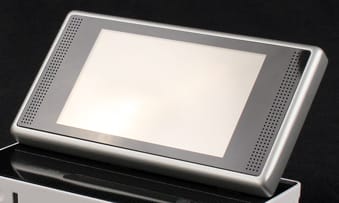
...but it turns into a nice 3-inch widescreen in playback mode.
Flash
{{section_header}}{{section.name}}{{/section_header}}
The S100's flash apparatus is fully motorized, meaning the bulb both deploys and retracts automatically. It's a cool feature we suppose, but since the flash is located right beneath the ideal spot for the left pointer finger, unexpected flash deployment can actually knock your grip out of place. Users who try to push the assembly back inside are met with pretty strong resistance, so we're guessing the hardware isn't designed for that. The move is part of a trend we're just beginning to observe (Nikon's S8200 does the same thing), but we're not yet sure we totally approve.

The flash emitter pops up from the top of the body via a mechanical release.
Lens
{{section_header}}{{section.name}}{{/section_header}}
Based on test results, Canon clearly paid close attention to this lens, yet as far as build construction it's a mix of flimsy and sturdy. The plastic enclosure feels rock-steady at the base, but a bit loose near the front. This may be intended so save on weight or even battery life (lighter elements require less energy to move), rather than production cost, but the difference stood out against the S100's otherwise solid body.

Optical zoom maxes out at 5x, enough for most everyday shooting. Wildlife or stadium photography will require a more ambitious zoom, and a less portable camera. For an ultracompact, this zoom ratio is pretty standard.
Battery
{{section_header}}{{section.name}}{{/section_header}}
The included NB-5L battery pack is CIPA rated at approximately 200 shots, placing it at the lower end of the ultracompact battery spectrum. Our time with the camera did confirm this analysis. Charging is accomplished via a wall socket adapter, and it is not possible to charge the battery simply by connecting the camera to a PC.

Memory
{{section_header}}{{section.name}}{{/section_header}}
The S100 is compatible with SD, SDHC, and fast SDXC cards, as well as Eye-Fi cards for easy wireless transfer (although compatibility with this feature is not guaranteed). We performed all our tests with an SDHC class card, and this worked just fine, access speed was never a problem.

Jacks, Ports & Plugs
{{section_header}}{{section.name}}{{/section_header}}
Both connectivity ports are concealed underneath a plastic cover on the body's right panel. There's a standard mini-USB port for PC and analog A/V output (although an A/V cable is not included with the S100), as well as a mini-HDMI port for lossless video and image output to HDTVs.
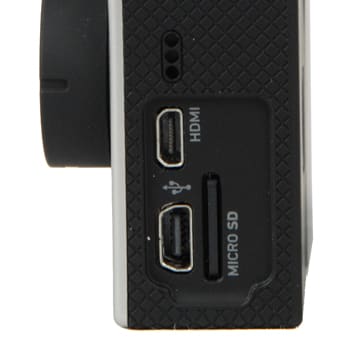
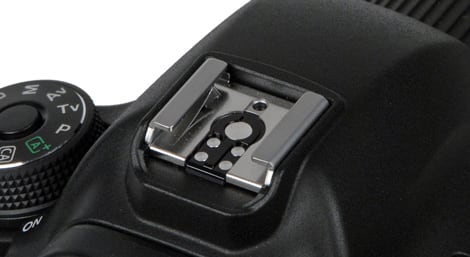
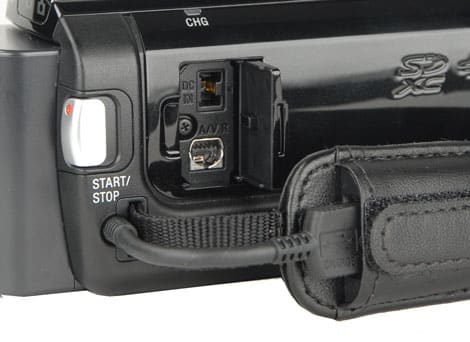
The DC-input and multi-AV port are located on the right side of the camcorder.
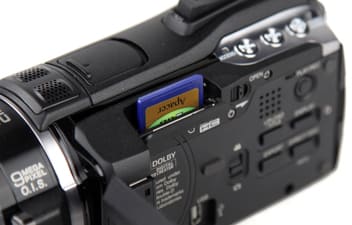
... as is the SD/SDHC card slot.
Other Hardware
{{section_header}}{{section.name}}{{/section_header}}
GPS Transceiver
The S100 is equipped with a GPS transceiver for "geo-tagging" of images, and believe it or not the feature actually works! Sure it takes about ten minutes to acquire a signal, but simply functioning places this device ahead of the competition. The camera is able to record detailed positioning information into the EXIF data, and can even determine elevation with sufficient satellites.
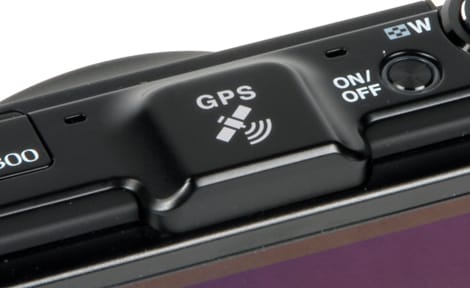
The new GPS module.
Shooting Modes
{{section_header}}{{section.name}}{{/section_header}}
Like the S95 before and many high-end compacts since, the S100 offers full "PASM" shooting, consisting of Program Auto, Aperture Priority, Shutter Priority, and Manual shooting modes. A fully customizable mode also has a home on the dial, as well as High Dynamic Range mode, Scene mode, a dedicated video mode, and a fully automatic mode.

The full mode dial is nice, but frequently rotates by accident.
Scene Modes
13 scene modes are available and few of them diverge from what is typical. Beach, Snow, Foliage, and the rest of the old favorites are there. A high speed full resolution burst mode is also hidden in the scene modes menu, and it's probably the most useful of the bunch.
Picture Effects
{{section_header}}{{section.name}}{{/section_header}}
This serious shooting camera is not equipped with any picture effects like Miniature or Magic Frame. We don't miss them, and we doubt the target audience will either.
Manual Controls
{{section_header}}{{section.name}}{{/section_header}}
The most useful manual control feature is of course the large control ring surrounding the lens. The ring is fully customizable, and may be assigned to variables like ISO, optical zoom, manual focus, etc. SLR users will love the extra control, while beginners may ignore the feature without consequence.
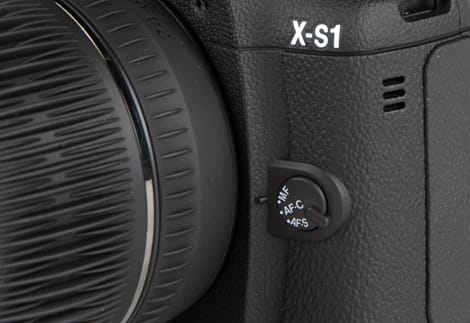
A dedicated focus-mode switch on the front panel.
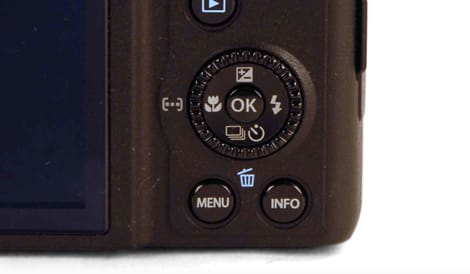
The scroll wheel surrounding the d-pad is neither awful nor perfect.
Drive/Burst Mode
{{section_header}}{{section.name}}{{/section_header}}
The S100 is capable of advanced drive mode shooting, however the fastest full resolution burst setting is hidden away as a scene mode. Continuous shooting, without the storage limitations of burst, is available from a setting in the quick menu. The self-timer features 10 second and 2 second countdowns, as well as a fully customizable setting, which we love.
Shot to Shot ({{product.raw_scores['Shot to Shot Score']}})
The High-speed Burst HQ scene mode captures full resolution shots at just over 8.5 frames per second, but the buffer maxes out after 8 shots. Continuous shooting is unlimited, but capture speed drops to 2.18 frames per second. RAW continuous shooting is also available, however this further limits speed to only 0.95 frames per second.
Handling
{{section_header}}{{section.name}}{{/section_header}}
Canon has added a thin, vertical strip of rubber to the front panel, giving the right index finger a place to latch onto. The material has a smooth quality, and isn't as grippy as we would've liked, but it's definitely an improvement over the S95.

An ergonomic feature has also been added to the rear, above the control panel. Here again, the rubber is smooth to the touch, and doesn't provide much of a grip in itself. But a taller lip on the right side of the grip does add some leverage.



These dedicated buttons give you quick access to aperture and shutter speed controls.
Buttons & Dials
{{section_header}}{{section.name}}{{/section_header}}
The undersized shutter release button is so small and out of the way that we actually found ourselves pressing the top of the mode dial accidentally. After getting used to it, you'll soon realize the placement is decent. A bigger problem is resistance. The release's second stage is strong, and the button is recessed into the surrounding zoom lever mechanism. This takes extra effort to manage and can introduce some shake into one-handed shooting.

Down below the thumb rest is Canon's excellent main control panel. The dual function directional pad / control dial is a fast and flexible way to input commands. The remaining buttons all have a short stroke but good tactile feedback and audible clicks.

Menus
{{section_header}}{{section.name}}{{/section_header}}
Canon's painless crossroads-style quick menu is accessible with only a single press of the central func./set button, it contains just about every variable you'll ever need to adjust, all within easy reach. For more detail, the tabbed main menu is opened with the menu button at the lower right corner. Here you'll find more options and more detail, with an interface based on the combination of zoom lever and control dial. The S100's menus are excellent all-around.
Manual & Learning
{{section_header}}{{section.name}}{{/section_header}}
The S100's included "Getting Started" manual is basic and unhelpful. Most users will want to download the full manual from Canon's website, which we found to be only moderately well-organized. In-camera help is not available, as is often the case with more expensive models.
Olympus XZ-1 Comparison
By almost every standard the S100 exceeds Canon’s own G12, and indeed replaces it in the PowerShot lineup. With more accurate colors, better handling of noise, sharper resolution, RAW encoding, and continuous or burst shooting, there’s very little reason for the clunky, aging G12 to exist anymore. And while the G12 certainly looks more professional, those who’ve done their research will know the compact S100 is actually the better camera.
Panasonic Lumix DMC-LX5 Comparison
We loved Olympus’ return to form when we first reviewed the XZ-1 back in March. For a long time, this model sat in the number one spot on our list of fixed-lens cameras. Times change, and the XZ-1’s rank has dropped a bit, but this camera remains one of the best ultracompacts out there.
But the S100 is better.
The margin is very slim, a few points here, a few points there; but by most metrics the S100 wins. Noise is the biggest difference between the two, thanks to the S100’s clear shots at low and medium ISOs. Canon also surpasses many of the XZ-1’s best features, such as burst mode and shooting controls. Current XZ-1 owners shouldn’t feel compelled to upgrade, but new shoppers should take note of the new ultracompact king.
COMP 3
In some cases, Panasonic’s Lumix DMC-LX5 offers the S100 its closest competition. The ability to reproduce color, for example, is neck-and-neck between the two. At other times however, the LX5 lags behind. Noise performance is downright poor, and resolution isn’t quite what it should be. The LX5’s mixed bag cannot compete with the S100’s consistent excellence, so our recommendation here should be obvious.
Conclusion
Following in the footsteps of the excellent S95, Canon once again strikes gold with the PowerShot S100. It’s a camera that fulfills the promise of every ultracompact: to cram an astounding level of power into a tiny, portable body. From now on, it is likely the S100 will be the point-and-shoot by which all others are judged.
Changes from the S95, where they exist, aren’t too drastic. It would be fair to call the S100 a “safe” design. But we can hardly complain about the new 12.1 megapixel CMOS sensor, which struggles with accuracy but excels in reduction of noise. We also love the new ergonomic features on the body’s front and rear, adding some much needed stability to the compact frame.
A few additions aren’t quite as useful, but never detract either. The fully-motorized automatic flash hardware might break your concentration at first, and the GPS transceiver is nice but unnecessary. Neither of these are deal-breakers though.
The remainder of what we love about the S100 is held over from the S95. An efficient menu makes shooting speedy and comfortable, the oversized front control ring is as stylish as it is functional, and the rock-solid body construction instills a sense of confidence and (we dare say) pride in the user’s hardware.
The Canon PowerShot S100 is an ideal first camera, perfect for aspiring photographers who are skilled but not yet ready to plunge into the land of interchangeable lenses. On the other hand, the S100 also makes a fine accessory for enthusiast level shooters, for situations in which SLRs or even system cameras aren’t desirable. Either way, we don’t expect anyone will regret their purchase.
Photo Gallery
{{photo_gallery "Front Photo", "Back Photo", "Sides Photo", "Top Photo", "Bottom Photo", "Lens Photo", "Flash Photo", "EVF Photo 1", "EVF Photo 2", "LCD Photo 1", "LCD Photo 2", "Media Photo", "Modes Photo", "Manual Controls Photo", "Manual Controls Photo 2", "Other Controls", "Buttons 1", "Buttons 2", "Other Hardware Photo", "Battery Photo", "Ports Photo 1", "Ports Photo 2", "Ports Photo 3", "Ports Photo 4", "Handling Photo 1", "Handling Photo 2", "Handling Photo 3", "Box Photo"}}
Meet the tester
Chris was born and raised less than ten miles from our editorial office, and even graduated from nearby Merrimack College. He came to Reviewed after covering the telecom industry, and has been moonlighting as a Boston area dining critic since 2008.
Checking our work.
Our team is here to help you buy the best stuff and love what you own. Our writers, editors, and experts obsess over the products we cover to make sure you're confident and satisfied. Have a different opinion about something we recommend? Email us and we'll compare notes.
Shoot us an email